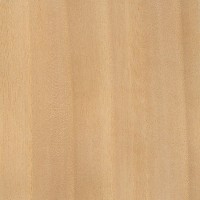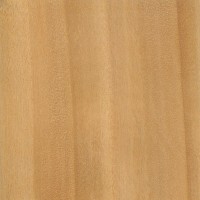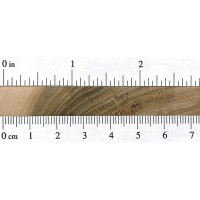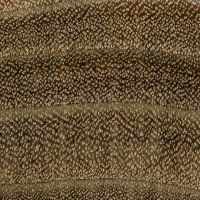 |
Common Name(s): Black Willow Scientific Name: Salix nigra Distribution: Eastern United States Tree Size: 65-100 ft (20-30 m) tall, 2-3 ft (.6-1 m) trunk diameter Average Dried Weight: 26 lbs/ft3 (415 kg/m3) Specific Gravity (Basic, 12% MC): .36, .42 Janka Hardness: 430 lbf (1,920 N) Modulus of Rupture: 7,800 lbf/in2 (53.8 MPa) Elastic Modulus: 1,010,000 lbf/in2 (6.97 GPa) Crushing Strength: 4,100 lbf/in2 (28.3 MPa) Shrinkage: Radial: 3.3%, Tangential: 8.7%, Volumetric: 13.9%, T/R Ratio: 2.6 |
Color/Appearance: Heartwood is a reddish or grayish brown, sometimes with darker streaks. The sapwood is white to tan, and isn’t always clearly or sharply demarcated from heartwood.
Grain/Texture: Willow usually has an interlocked or irregular grain with a medium to fine uniform texture.
Endgrain: Semi-ring-porous (very subtle change in pore size from earlywood to latewood sometimes overlooked as diffuse-porous); medium to large pores in no specific arrangement, moderately numerous to numerous; commonly in radial multiples of 2-3; narrow rays not visible—sometimes even with the aid of hand lens, spacing normal to close; parenchyma banded (marginal).
Rot Resistance: Rated as non-durable to perishable, and also susceptible to insect attack.
Workability: With its low density and interlocked grain, willow has very poor machining characteristics, frequently resulting in fuzzy surfaces or tearout. Willow also tends to develop numerous drying defects and can be difficult to season. Glues and finishes well. Responds moderately well to steam bending.
Odor: No characteristic odor.
Allergies/Toxicity: There have been very few adverse health effects associated with the actual wood of willow (Salix genus), however, the bark and other parts of the tree have been reported as sensitizers. Usually most common reactions simply include skin and respiratory irritation. See the articles Wood Allergies and Toxicity and Wood Dust Safety for more information.
Pricing/Availability: Willow isn’t an overly common furniture wood in the United States, though it seems to be in abundant supply. Prices are likely to be quite economical throughout its natural range.
Sustainability: This wood species is not listed in the CITES Appendices or on the IUCN Red List of Threatened Species.
Common Uses: Baskets, utility wood, crates, furniture, carvings, and other small specialty wood items.
Comments: With hundreds of species of willows worldwide—including the popular Asian cultivar Weeping Willow (Salix x sepulcralis)—the world of willows is highly varied in shape and size. Black Willow (Salix nigra) is one of the largest and most commerically important species of willow in North America.
Willow is a lightweight hardwood with good shock resistance, but overall is weak for its weight. These characteristics, coupled with its sub-par workability, restrict willow to mostly rough, utilitarian purposes.
None available.
Scans/Pictures: A special thanks to Steve Earis for providing the wood sample (veneer) of this wood species. (Please note that the endgrain samples are from a different wood sample containing both sapwood and heartwood, as can be seen by the color disparity between the two samples.)








I certainly agree with the description of the workability of the wood. I turned a biscuit cutter about 3 inches round out of piece of streaked heartwood. It was fuzzy working on the lathe and the two 1/4″ drill holes were ragged. I gave up trying to sand it smooth and instead put a walnut oil and bees wax finish on it. I completed it about a week ago and noticed that the 3 inch round biscuit will now be a 2 3/4 x 3 1/4 inch oval. No cracks have developed as yet though. But I’m sure the oval… Read more »
Works great as a tool for friction fire (Bow Drill) it’s my Goto wood for this purpose. easy to spot and can frequently find it dead but standing which will make it dryer then wood on the ground.